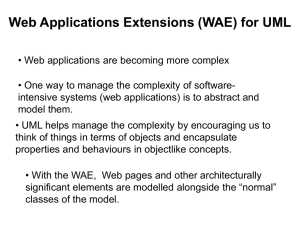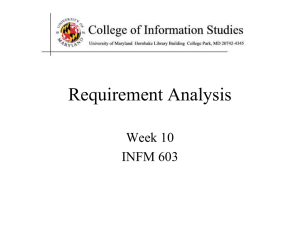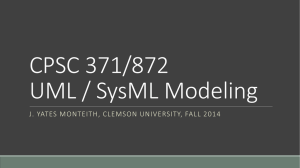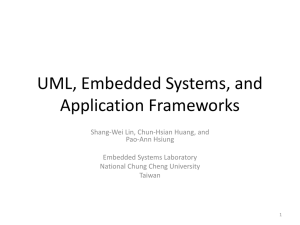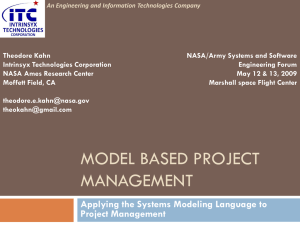UML Modeling
advertisement
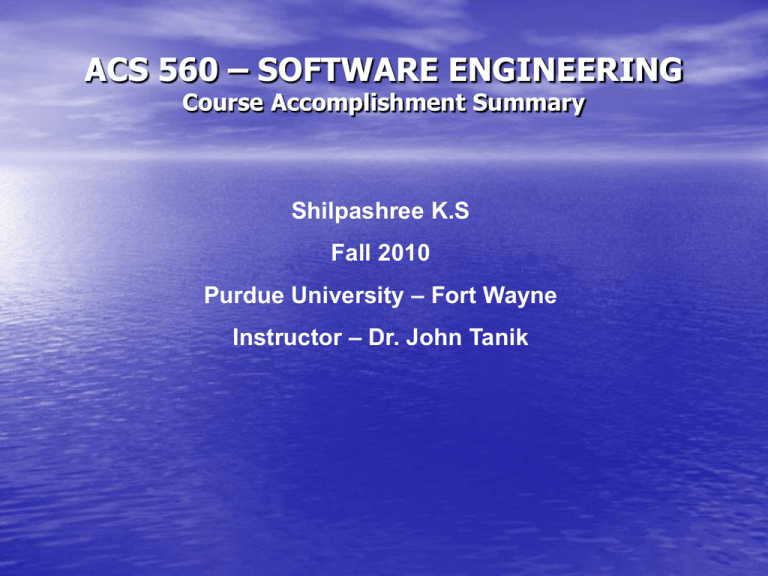
ACS 560 – SOFTWARE ENGINEERING Course Accomplishment Summary Shilpashree K.S Fall 2010 Purdue University – Fort Wayne Instructor – Dr. John Tanik PART 1 • Study on C-Map • Research on project topic • Study and Review (Summary) of Text Book Chapters • Review of the Scholarly papers • Summarize SWEBOK Knowledge Areas Project Topic Research • Went Through http://www.openclinical.org/ http://www.purdue.edu/discoverypark/rche/ to get more details about biomedical research field • Surveyed the nutrition requirement and exercises for various types of people depending on their life style from various websites • Created a draft version of the Project proposal for “Health Monitor – Managing Diet and Fitness for Healthy Living” Chapter Reviews Part I: UML Notation, Design Concepts, Technology, Life Cycles and Methods • • • • • Chapter Chapter Chapter Chapter Chapter 1 : Introduction 2: Overview of UML Notation 3: Software Design and Architecture Concepts 4: Concurrent and Distributed System Technology 5: Software Life Cycles and Methods Chapter Reviews Part II: COMET: Concurrent Object Modeling And Architectural Design With UML • • • • • • • • • • • Chapter Chapter Chapter Chapter Chapter Chapter Chapter Chapter Chapter Chapter Chapter 6 : Overview of COMET 7 : Use Case Modeling 8 : Static Modeling 9 : Object and Class Structuring 10 : Finite State Machines And Statecharts 11 : Dynamic Modeling 12 : Software Architecture Design 13 : Architectural Design of Distributed Applications 14 : Task Structuring 15 : Class Design 16 : Detailed Software Design Review of the Scholarly Papers • Representing Clinical Guidelines in UML: A Comparative Study • A UML Approach to Process Modelling of Clinical Practice • • • • Guidelines for Enactment Enhancing Object-Oriented Software Development through Axiomatic Design. A UML 2.0 Profile for SystemC: Toward Highlevel SoC Design SysML and Systems Engineering Applied to UML based SoC Design Designing Real-Time and Embedded Systems with the COMET / UML method Summarize SWEBOK Knowledge Areas • • • • • • • • • • • KA KA KA KA KA KA KA KA KA KA KA 1: Software Requirements 2: Software Design 3: Software Construction 4: Software Testing 5: Software Maintenance 6: Software Configuration Management 7: Software Engineering Management 8: Software Engineering Process 9: Software Engineering Tools and Methods 10: Software Quality 11: Knowledge Areas of Related Desciplines PART 2 • Implementation of Inception Phase of RUP • Implementation of Elaboration Phase of RUP Implementation of Inception Phase Implementation of Inception Phase • Research • Business Modeling • Requirements • Analysis and Design Research • DIET, NUTRITION AND THE PREVENTION OF CHRONIC DISEASES • Diet and Nutrition Surveillance for Chronic Disease: A White Paper on the National Report on Biochemical Indicators of Diet and Nutrition in the U.S. Population – 1999-2002 • Chronic Disease Alliance: A Unified Approach Research • Preventing Chronic Disease : Public Health Research, Practice, and Policy • Low-Fat Diet and Chronic Disease Prevention: the Women’s Health Initiative and Its Reception • Pennsylvania Nutrition and Physical Activity Plan to Prevent Obesity and Related Chronic Diseases: Department of Health Research • OMG Systems Modeling Language Tutorial • Introduction to UML • IEEE recommended practice for software requirements specifications. • IEEE 1016 – Recommended Practices for Software Design Description Business Modeling • Vision Document: A general vision of the core project’s requirements, key features, and main constraints • An Initial Business Case Document which includes business context, success criteria, and financial forecast Requirements • • • • Voice of Customer Document Customer Needs Document Functional Requirements Document Project Glossary Document Analysis and Design • • • • Axiomatic Design Initial Use Case Model Project Plan Initial Risk Assessment Axiomatic Design FR-DP Design Matrix Axiomatic Design DP-DP Design Matrix Axiomatic Design Customer Needs Axiomatic Design FR-DP Decomposition Axiomatic Design Quality Function Deployment An Initial Use Case Model Project Plan Project Plan (Contd) Project Plan (Contd) Risk Analysis Implementation of Elaboration Phase Implementation of Elaboration Phase • Business Modeling • Requirements • Analysis and Design Business Modeling • Business Case Document which includes business context, success criteria, and financial forecast Software Requirements Specification • • • Introduction Overall Description – Product Perspective, Product Functions, User Characteristics, Stakeholder Needs, General Constraint, Assumptions & Dependencies Specific Requirements – Functional Requirements – External Interface Requirements – Performance Requirements – Design Constraints – Software System Attributes – Other Requirements Software Requirements Specification Software Requirements Specification Software Design Descriptions • Overview – Introduction, Purpose, Scope, Assumptions and General Constraints, Definitions, Reference Documents • Stakeholder – Identification, Concerns • Software Architecture Overview – Viewpoint - Views Summary, Architecture Goals and Constraints • Architecture Viewpoint – Architecture Viewpoint summary, UML & SysML diagram System Block Diagram UML Modeling Data Flow Diagram UML Modeling Activity Diagram UML Modeling Activity Diagram UML Modeling Sequence Diagram UML Modeling Class Diagram UML Modeling State Chart Diagram UML Modeling Deployment Diagram SysML Modeling Requirements Diagram SysML Modeling Activity Diagram Thank You




